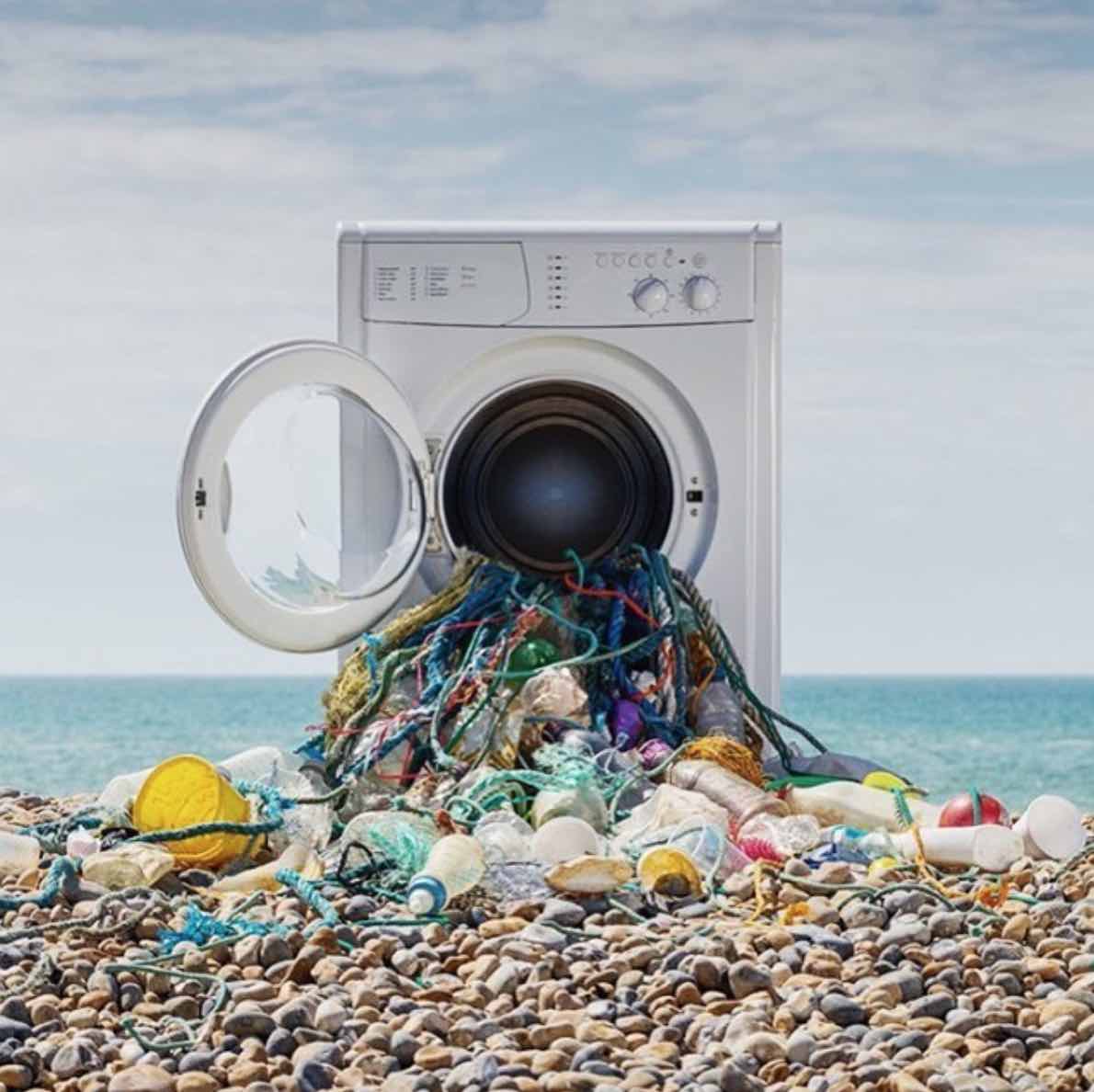Microplastics from Synthetic Fabrics
As synthetic fabrics dominate fast fashion, every wash and wear releases microfibers that ultimately pollute oceans, infiltrate food chains, and even affect human health.
 McCurdy, L. (2024). Microplastics from synthetic fibers are released into the environment [Photograph]. Planet Care Solutions. https://ourgoodbrands.com/microplastic-pollution-fashion-synthetic-vs-plant-based-textiles/
McCurdy, L. (2024). Microplastics from synthetic fibers are released into the environment [Photograph]. Planet Care Solutions. https://ourgoodbrands.com/microplastic-pollution-fashion-synthetic-vs-plant-based-textiles/
What Are Microplastics and Why Do They Matter?
Microplastics are plastic particles smaller than 5 mm, and in the context of textiles, they primarily originate from synthetic fibers like polyester, acrylic, nylon, and spandex. These fibers are widely used in fast fashion because of their affordability, stretch, and durability. However, these same fabrics are responsible for shedding microplastics during production, usage, and especially laundering (Periyasamy & Tehrani-Bagha, 2022).
Every time a synthetic garment is washed, hundreds of thousands of microfibers can be released into wastewater systems, many of which are too small to be captured by filtration processes. Eventually, these microplastics flow into rivers, lakes, and oceans, contributing to a global environmental crisis (Periyasamy & Tehrani-Bagha, 2022).
Fast Fashion’s Dependency on Synthetic Fabrics
Fast fashion relies heavily on synthetic materials due to their low cost and ease of manipulation. Polyester, in particular, accounts for the majority of global fiber production and is present in everything from dresses to gym wear. But these materials do not biodegrade and persist in the environment for hundreds of years, fragmenting into smaller and smaller particles over time (Periyasamy & Tehrani-Bagha, 2022).
Moreover, the fast fashion model emphasizes speed over sustainability. Clothes are often designed to last only a few wears before being discarded. This rapid cycle increases microfiber pollution because low-quality garments shed more fibers due to weaker fabric structure and inferior finishing techniques (Periyasamy & Tehrani-Bagha, 2022).
Environmental Consequences of Microfiber Emissions
Figure 1
Fiber fragments mitigation into the aquatic environment

Note. Main sources for the fiber fragments mitigation into the aquatic environment from domestic washing, textile industries, and garment waste/landfills and risks of fiber fragments for human and animal exposure. Adapted from Periyasamy, A. P., & Tehrani-Bagha, A. (2022). A review on microplastic emission from textile materials and its reduction techniques. Polymer Degradation and Stability, 199, 109901. https://doi.org/10.1016/j.polymdegradstab.2022.109901. Copyright 2022 by the authors.
The environmental impact of synthetic textile microplastics is immense. These fibers have been found in remote mountain regions, Arctic ice, marine sediments, and even atmospheric air. Once they enter aquatic environments, they accumulate in organisms across the food web, as shown in Figure 1, from plankton to fish and marine mammals. Over time, these fibers can cause physical damage, chemical toxicity, and reproductive harm in marine life (Periyasamy & Tehrani-Bagha, 2022).
What’s more troubling is the indirect effect on humans. When seafood containing microplastics is consumed, these particles can end up in our bodies. Though research is ongoing, early findings suggest potential risks to human health, including inflammatory responses and the accumulation of toxic substances (Periyasamy & Tehrani-Bagha, 2022).
The Role of Washing and Fabric Construction
Home laundering is a major source of microfiber release. Factors such as water temperature, detergent type, and washing machine design all influence how many fibers are shed. Fabrics made with loose yarn structures, staple fibers, or mechanical finishing (like brushing or sanding) tend to emit more microplastics compared to tightly woven fabrics (Periyasamy & Tehrani-Bagha, 2022).
Even air-drying and regular wear contribute to microfiber shedding, making the problem nearly unavoidable. With the average consumer doing multiple loads of laundry per week, the cumulative effect of this release is staggering.
Reducing Microplastic Pollution: What Can Be Done?
While the problem is widespread, reduction strategies are emerging at both the industry and consumer levels. Periyasamy and Tehrani-Bagha (2022) identify several key methods to limit microfiber emissions:
- Material Innovation: Using filament yarns instead of staple fibers can significantly reduce fiber loss. Additionally, blending synthetic materials with natural fibers like cotton or wool helps minimize plastic release.
- Fabric Finishing Techniques: Applying coatings such as bio-based polymers or plasma treatments can help fabrics resist shedding. These finishes act as protective layers that reduce mechanical friction during wear and washing.
- Washing Modifications: Simple changes like using front-loading washing machines, washing clothes less frequently, choosing colder water settings, and using laundry bags or filters can drastically reduce fiber loss.
- Design and Production Responsibility: Brands should prioritize durability, avoid overly aggressive fabric finishes, and invest in long-lasting design. Encouraging “slow fashion” practices can shift the consumer mindset toward quality over quantity.
Source: Periyasamy, A. P., & Tehrani-Bagha, A. (2022). A review on microplastic emission from textile materials and its reduction techniques. Polymer Degradation and Stability, 199, 109901. https://doi.org/10.1016/j.polymdegradstab.2022.109901

